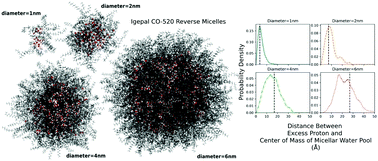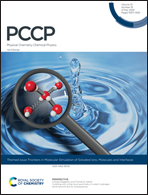Interfacial solvation and slow transport of hydrated excess protons in non-ionic reverse micelles†
Abstract
This work employs molecular dynamics simulations to investigate the solvation and transport properties of hydrated excess protons (with a hydronium-like core structure) in non-ionic Igepal CO-520 reverse micelles of various sizes in a non-polar solvent. Multiscale Reactive Molecular Dynamics (MS-RMD) simulations were used to describe vehicular and hopping diffusion during the proton transport process. As detailed herein, an excess proton shows a marked tendency to localize in the interfacial region of micellar water pools. Slow proton transport was observed which becomes faster with increasing micellar size. Further analysis reveals that the slow diffusion of an excess proton is a combined result of slow water diffusion and the low proton hopping rate. This study also confirms that a low proton hopping rate in reverse micelles stems from the interfacial solvation of hydrated excess protons and the immobilization of interfacial water. The low water density in the interfacial region makes it difficult to form a complete hydrogen bond network near the hydrated excess proton, and therefore locks in the orientation of hydrated proton cations. The immobilization of the interfacial water also slows the relaxation of the overall hydrogen bond network.

- This article is part of the themed collection: Frontiers in Molecular Simulation of Solvated Ions, Molecules and Interfaces


 Please wait while we load your content...
Please wait while we load your content...
